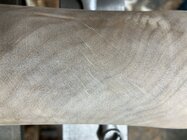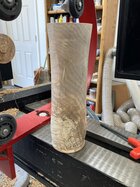Occasionally I've seen caution to avoid sanding so much the wood is heated and cracks. Has anyone experienced this, and if so what do these crackis look like? With the grain? Across the grain? Very small hard to find cracks or noticeable ones? Thanks.
-
December 2025 Turning Challenge: Single Tree! (click here for details) -
Congratulations to Bob Henrickson, People's Choice in the November 2025 Turning Challenge (click here for details) -
Congratulations to Guillaume Fontaine for "Old Tea Pot" being selected as Turning of the Week for December 15, 2025 (click here for details) -
Welcome new registering member. Your username must be your real First and Last name (for example: John Doe). "Screen names" and "handles" are not allowed and your registration will be deleted if you don't use your real name. Also, do not use all caps nor all lower case.
You are using an out of date browser. It may not display this or other websites correctly.
You should upgrade or use an alternative browser.
You should upgrade or use an alternative browser.
Sanding "Heat" Cracks
- Thread starter Don Stephan
- Start date
I had some obvious checks open up between the fibers when sanding the base of a partially dry endgrain hollow form aggressively with 80# to remove a tailstock nub. Now I use a carbide burr in a rotary tool and clean up carefully with a sander. I think it's unlikely to happen when sanding at a moderate rate on dry wood with sharp abrasives.
I have not seen this, at least not that I can recall. I suspect that most folks use too much pressure when using a drill to sand or a RO sander. More pressure = more heat.
Dave Landers
Beta Tester
They're usually small cracks and often there's a bunch of them together. They're like any other crack you get from drying wood too quickly (cause that's what is happening).
The cracks are not really about sanding too much (that has other issues) but it's about friction and heat - pressing too hard, sanding with old paper (no grit left), lathe (or sander) running too fast, etc.
Friction heats, and thus drys out, the surface of the wood quickly, and the wood reacts. (Even "dry' wood is not truly dry).
The cracks are not really about sanding too much (that has other issues) but it's about friction and heat - pressing too hard, sanding with old paper (no grit left), lathe (or sander) running too fast, etc.
Friction heats, and thus drys out, the surface of the wood quickly, and the wood reacts. (Even "dry' wood is not truly dry).
Like Dave said, a bunch of very small and usually very short cracks, and on the end grain. I have seen the same thing from torching the wood to get the color, and especially if the wood is still kind of wet. It is not easy to do on dry wood, you have to spin pretty fast and apply a lot of pressure. I am not sure it can be done with any of the power sanders, you have to do it with hand sanding, and more often the finer grits. If you are hand sanding and have your hand on the wood, you can feel the heat, unless you are using a sanding pad. Never do the sanding pad thing, it lets you know when the wood is getting too hot...
robo hippy
robo hippy
The most common issue is with very hard exotic woods. Especially if they were bought with a wax coating. It's really a moisture issue with the wood that causes it.
A couple months ago I had a small scrap piece of maple (firewood) laying on the ground outside and a friend challenged me to turn it. So... I did. I made a vase. The wood was not green but also not dry. I turned a 3x10" vase. Given it was a challenge I turned it fast, hollowed it fast and sanded it fast. As I was sanding the inside, it got hot and sure enough cracks developed. It happened because the wood had a high moisture content and I sanded it aggressively, causing heat buildup. Nice pencil holder though.
Attachments
It will happen on many of the Aussie hardwoods if you get carried away. Luckily, many of these hardwoods are often very dark CA will take care of it
I’ve had this happen with cedar, poplar, and walnut. In every case, the wood was a little on the wet side (~18%MC) and I was power sanding with the lathe going way too fast. Once I slowed the lathe (and the sander) down, this stopped happening.
Thanks everyone for the explanations!


